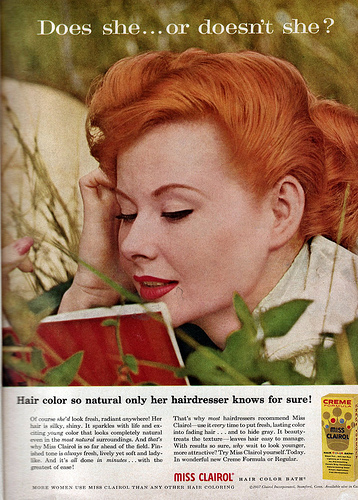Changing Beliefs About Hair Color
Changing Beliefs About Hair Color
 There was an article in Adweek magazine a few years ago that discussed how women weren’t open to using hair-color products when they were first introduced in the 1950s. In 1956, Clairol introduced “Miss Clairol,” a “hair color bath” for women that provided a one-step product for natural-looking results.
There was an article in Adweek magazine a few years ago that discussed how women weren’t open to using hair-color products when they were first introduced in the 1950s. In 1956, Clairol introduced “Miss Clairol,” a “hair color bath” for women that provided a one-step product for natural-looking results.
Clairol had a difficult time selling its new product to the public because there was a social stigma among women against dyeing their hair. At that time, it was common knowledge that the only women who dyed their hair were stage actresses and women who had questionable morals.
In order to sell American women on its new hair-color product, Clairol hired Shirley Polykoff, the only female advertising expert employed at the well-known New York advertising agency Foote, Cone & Belding. Polykoff determined that the only way to persuade women to buy the product was to convince them that Miss Clairol was so natural looking that nobody would ever guess that they had colored their hair.
Polykoff came up with the tagline “Does she … or doesn’t she?” Below the tagline was the statement “Hair color so natural, only her hairdresser knows for sure!” Six years after Polykoff took over the account, sales for Miss Clairol reached $200 million.
A couple of weeks ago, I stopped at a local grocery store to pick up a few items. The color of the young woman’s hair at the checkout counter was a solid, unflattering green color. A few days later, I was waited on at one of the local banks by a woman who had hair that was about 14 inches in length. The first six inches of her hair were a bleach-blond color, and the remaining eight inches were a dark brown color. She looked like a woman you would see in one of the Star Trek movies.
Sixty years ago women did everything they could to hide the fact that they colored their hair. Today, women frequently color their hair so they can stand out and get attention and recognition. The same applies to the proliferation of tattoos, and nose rings and various other forms of “jewelry” that are poked into and connected to people’s tongues, noses, ears, and other parts of their faces.
In my article last week, I wrote about how I was treated by some of my teachers at St. Mark’s Catholic grade school during the 1960s. Just as our attitudes and beliefs about hair color, tattoos, and facial jewelry have dramatically changed over the past 60 years, our attitudes and beliefs have also changed concerning the correct form of discipline that should be administered to children and teenagers by their parents and teachers.
When I was a teenager, I had a cousin Mike who was a great athlete with lightning-fast reflexes. Mike told me about an incident that happened in a classroom of the Catholic school he attended. The class was taught by a young priest who had been a former pitcher for a baseball team.
Whenever one of the boys in the class misbehaved, the teacher threw his large ring of keys at the boy. The boy would immediately react by turning and covering his head with his hands in anticipation of being hit by the keys. The keys usually hit an arm, shoulder, hand, or whatever other part of the boy’s body was exposed while he was attempting to protect himself.
On one particular occasion, Mike said something to the priest that was inappropriate. The priest reacted by throwing his keys at Mike. Mike caught the keys and immediately hurled them back at the priest, and they hit him in the chest. Mike ended up being disciplined by the school for his behavior. Two things happened after that: (1) the priest never threw his keys at Mike again, and (2) the priest was a little more respectful to Mike.
During the 1960s, many parents and teachers believed it was okay to abuse and humiliate boys. In fact, a lot of parents and teachers felt that abusing and humiliating boys was a necessary part of transforming them into real men.
Now, 60 years later, for the majority of people, those beliefs have been replaced by the belief that we have to cater to the feelings of our boys. Parents and teachers are expected to be highly sensitive to boys’ feelings and are chastised and called bullies if they push them too hard. Then, of course, they’re disappointed if the boys grow up to be wimps who are unable to cope with adult-related issues and incapable of effectively competing in the real world.
While I’m opposed to the methods that were used by some of my grade school teachers to get me to conform — physical abuse and humiliation — I’m not opposed to the way they pushed me and my fellow students to embrace and practice self-reliance, ambition, competition, a strong study ethic, and a strong work ethic.
While there have been some positive developments over the past 60 years in the way that most teachers and parents discipline their boys, there have also been some negative developments.
From a positive standpoint, their beliefs concerning the use of physical abuse and humiliation to get what they want have, to a certain extent, been abandoned. Unfortunately, what has also been abandoned to a large degree is the insistence that our boys practice and engage in initiative, self-reliance, ambition, competition, and hard work.
In today’s society, too many of our teachers and parents are encouraging their boys to get more in touch with their feelings and to be more sensitive to the feelings of others, instead of channeling their ambition and aggression toward building greater initiative, self-reliance, competiveness, and hard work.
More on this topic next week.




3 Comments
Sorry about your experience with the Sisters in grade school.
I am most appreciative of all the Sisters did for me at St,Patrick’s school. They gave me all the help, guidance,and attention I needed. They taught this 7 year old how to speak English, read ,write,and how to pray and act. I owe all I accomplished to Sister Patrice,Hillary,Patricia,Thomas Moore,and others.
Any corrections or ” punishment ” given to was desirved,even if I did not feel so at that time.
My only regrets are that I never able to thank them and tell them of any of my successes was due to their work ,patience,and prayers.
I can only remember ,pray for them ,and thank God for putting them in my life.
Ray – My older sister Mary learned how to read from the religious sisters at St. Patrick’s school and was treated with kindness, love, and respect. You were fortunate to have them as your teachers. Thanks for your comment. Harry
Dear Harry and Georgette –
My last comment to you covered this one as well as the last one, so I’ll await your next week’s before commenting again. [The coloring of the hair didn’t affect me, so needs no comment!]
w/love for both of you! Sister Roberta